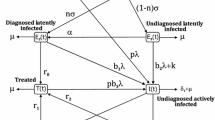Abstract
A deterministic model of tuberculosis without and with seasonality is designed and analyzed into its transmission dynamics. We first present and analyze a tuberculosis model without seasonality, which incorporates the essential biological and epidemiological features of the disease. The model is shown to exhibit the phenomenon of backward bifurcation, where a stable disease-free equilibrium coexists with one or more stable endemic equilibria when the associated basic reproduction number is less than unity. The statistical data of tuberculosis (TB) cases show seasonal fluctuations in many countries. Then, the extension of our TB model by incorporating seasonality is developed and the basic reproduction ratio is defined. Parameter values of the model are estimated according to demographic and epidemiological data in Cameroon. The simulation results are in good accordance with the seasonal variation of the reported cases of active TB in Cameroon.
Similar content being viewed by others
References
World Health Organization: Global tuberculosis control: surveillance, planning, financing. World Health Organization, Geneva, Switzerland (2009)
Dye, C., Schele, S., Dolin, P., Pathania, V., Raviglione, M.: For the WHO global surveillance and monitoring project. Global burden of tuberculosis estimated incidence, prevalence and mortality by country. JAMA 282, 677–686 (1999)
Raviglione, M.C., Dye, C., Schmizt, S., Kochi, A.: For the global surveillance and monitoring project: assessment of worldwide tuberculosis control. Lancet 350, 624–629 (1997)
Raviglione, M.C.: Evolution of WHO, 1948–2001 policies for tuberculosis control. Lancet 359, 775–780 (2002)
Frieden, T., Driver, R.C.: Tuberculosis control: past 10 years and future progress. Tuberculosis 83, 82–85 (2003)
Feng, Z., Castillo-Chavez, C., Capurro, A.F.: A model for tuberculosis with exogenous reinfection. Theor. Popul. Biol. 57, 235–247 (2000)
Chiang, C.Y., Riley, L.W.: Exogenous reinfection in tuberculosis. Lancet Infect. Dis. 5, 629–636 (2005)
Grassly, N.C., Fraser, C.: Seasonality infectious disease epidemiology. Proc. R. Soc. B 273, 2541–2550 (2006)
Hethcote, H.W., Yorke, J.A.: Gonorrhea Transmission Dynamics and Control. Lecture Notes in Biomathematics, vol. 56, p. 105. Springer, Berlin (1984)
Schaaf, H.S., Nel, E.D., Beyers, N., Gie, R.P., Scott, F., Donald, P.R.: A decade of experience with Mycobacterium tuberculosis culture from children: a seasonal influence of children tuberculosis. Tuberc. Lung Dis. 77, 43–46 (1996)
Douglas, A.S., Strachan, D.P., Maxwell, J.D.: Seasonality of tuberculosis: the reverse of other respiratory disease in the UK. Thorax 51, 944–946 (1996)
Leung, C.C., Yew, W.W., Chan, T.Y.K., Tam, C.M., Chan, C.Y., Chan, C.K., Tang, N., Chang, K.C., Law, W.S.: Seasonal pattern of tuberculosis in Hong Kong. Int. J. Epidemiol. 34, 924–930 (2005)
Rios, M., Garcia, J.M., Sanchez, J.A., Perez, D.: A statistical analysis of the seasonality in pulmonary tuberculosis. Eur. J. Epidemiol. 16, 483–488 (2000)
Nagayama, N., Ohmori, M.: Seasonality in various forms of tuberculosis. Int. J. Tuberc. Lung Dis. 10, 1117–1122 (2006)
Thorpe, L.E., Frieden, T.R., Laserson, K.F., Wells, C., Khatri, G.R.: Seasonality of tuberculosis in India: is it real and what does it tell us? Lancet 364, 1613–1614 (2004)
Akhtar, S., Mohammad, H.G.: Seasonality in pulmonary tuberculosis among migrant workers entering Kuwait BMC Infect. Dis. 8, 3–13 (2008). doi:10.1186/1471-2334-8-3
Liu, L., Zhao, X.-Q., Zhou, Y.: A tuberculosis model with seasonality. Bull. Math. Biol. 72, 931–952 (2010). doi:10.1007/s11538-009-9477-8
Janmeja, A.K., Mohapatra, P.R.: Seasonality of tuberculosis. Int. J. Tuberc. Lung Dis. 9, 704–705 (2005)
Aron, J.L., Schwartz, I.B.: Seasonality and period-doubling bifurcations in an epidemic model. J. Theor. Biol. 110, 665–679 (1984)
Greenman, J., Kamo, M., Boots, M.: External forcing of ecological and epidemiological systems: a resonance approach. Physica D 190, 136–151 (2004)
Altizer, S., Dobson, A., Hosseini, P., Hudson, P., Pascual, M., Rohani, P.: Seasonality and the dynamics of infectious diseases. Ecol. Lett. 9, 467–484 (2006)
Hethcote, H.W.: The mathematics of infectious diseases. SIAM Rev. 42, 599–653 (2000)
Anderson, R.M., May, R.M.: Infectious Disease of Humans, Dynamical and Control. Oxford University Press, Oxford (1992)
Anderson, R.M., May, R.M.: Population biology of infectious diseases: Part I. Nature 280, 361–367 (1879)
Capasso, V.: Mathematical Structures of Epidemic Systems. Lecture Notes in Biomathematics, vol. 97. Springer, Berlin (1993)
Thieme, H.R.: Mathematics in Population Biology, Princeton. Ser. Theor. Comput. Biol. Princeton University Press, Princeton (2003)
Castillo-Chavez, C., Song, B.: Dynamical models of tuberculosis and their applications. Math. Biosci. Eng. 1, 361–404 (2004)
Castillo-Chavez, C., Feng, Z.: To treat or not to treat: the case of tuberculosis. J. Math. Biol. 35, 629–635 (1997)
Bhunu, C.P., Garira, W., Mukandawire, Z., Zimba, M.: Tuberculosis transmission model with chemoprophylaxis and treatment. Bull. Math. Biol. 70, 1163–1191 (2009). doi:10.1007/S11538-008-9295-4
Blower, S.M., Small, P.M., Hopwell, P.C.: Control strategies for tuberculosis epidemics: new models for old problems. Science 273, 497–520 (1996)
Murphy, B.M., Singer, B.H., Kirschner, D.: Comparing epidemic tuberculosis in demographically distinct populations. Math. Biosci. 180, 161–185 (2002)
Murphy, B.M., Singer, B.H., Kirschner, D.: On the treatment of tuberculosis in heterogeneous populations. J. Theor. Biol. 223, 391–404 (2003)
Bacaer, N., Ouifki, R., Pretorious, C., Wood, R., William, B.: Modelling the joint epidemics of TB and HIV in a South African township. J. Math. Biol. 57, 557–593 (2008)
Blower, S.M., Small, P.M., Hopewell, P.C.: Control strategies for tuberculosis epidemics: new models for old problems. Science 273, 497–500 (1996)
Blower, S.M., Porco, T.C., Lietman, T.M.: Tuberculosis: the evolution of antibiotic resistance and the design of epidemic control strategies. In: Horn, M.A., Simonett, G., Webb, G.F. (eds.) Mathematical Models in Medical and Health Science. Vanderbilt University Press, Nashville (1998)
Chintu, C., Mwinga, A.: An African perspective of tuberculosis and HIV/AIDS. Lancet 353, 997–1005 (1999)
Bowong, S., Tewa, J.J.: Mathematical analysis of a tuberculosis model with differential infectivity. Commun. Nonlinear Sci. Numer. Simul. 14, 4010–4021 (2009)
Bowong, S.: Optimal control of the transmission dynamics of tuberculosis. Nonlinear Dyn. 61, 729–748 (2010). doi:10.1007/s11071-010-9683-9
National Comittee of Fight Againts Tuberculosis: Guide de personnel de la santé (2001)
Berman, A., Plemmons, R.J.: Nonnegative Matrices in the Mathematical Sciences. SIAM, Philadelphia (1994)
Jacquez, J.A., Simon, C.P.: Qualitative theory of compartmental systems. SIAM Rev. 35, 43–79 (1993)
Smith, H.L., Waltmann, P.: The Theory of the Chemostat. Cambridge University Press, Cambridge (1995)
Smith, H.L.: Monotone Dynamical Systems: An Introduction to the Theory of Competitive and Cooperative Systems. Mathematical Surveys and Monographs, vol. 41. Am. Math. Soc., Providence (1995)
National Institute of Statistics: Evolution des systèmes statistiques nationaux (2007)
van den Driessche, P., Watmough, J.: Reproduction numbers and sub-threshold endemic equilibria for compartmental models of disease transmission. Math. Biosci. 180, 29–28 (2002)
Feng, Z., Chavez, C., Capurro, A.: A model for tuberculosis with exogenous reinfection. Theor. Popul. Biol. 57, 235–247 (2000)
Dushoff, J., Huang, W., Castillo-Chavez, C.: Backwards bifurcations and catastrophe in simple models of fatal diseases. J. Math. Biol. 36, 227–248 (1998)
Brauer, F.: Backward bifurcation in simple vaccination models. J. Math. Anal. Appl. 298, 418–431 (2004)
Chiang, C.Y., Riley, L.W.: Exogenous reinfection in tuberculosis. Lancet Infect. Dis. 5, 629–636 (2005)
Arino, J., McCluskey, C.C., van den Driessche, P.: Global result for an epidemic model with vaccination that exhibits backward bifurcation. SIAM J. Appl. Math. 64, 260–276 (2003)
Sharomi, O., Podder, C.N., Gumel, A.B., Elbasha, E.H., Watmough, J.: Role of incidence function in vaccine-induced backward bifurcation in some HIV models. Math. Biosci. 210, 436–463 (2007)
Lakshmikantham, V., Leela, S., Martynyuk, A.A.: Stability Analysis of Nonlinear Systems. Marcel Dekker, New York (1989)
LaSalle, J.P.: The Stability of Dynamical Systems. Society for Industrial and Applied Mathematics, Philadelphia (1976). With an appendix: “Limiting equations and stability of nonautonomous ordinary differential equations” by Z. Artstein, Regional Conference Series in Applied Mathematics (1976)
LaSalle, J.P.: Stability theory for ordinary differential equations. J. Differ. Equ. 41, 57–65 (1968)
Bhatia, N.P., Szegö, G.P.: Stability Theory of Dynamical Systems. Springer, Berlin (1970)
Wang, W., Zhao, X.-Q.: Threshold dynamics for compartmental epidemic models in periodic environments. J. Dyn. Differ. Equ. 20, 699–717 (2008)
Saltelli, A., Chan, K., Scott, M. (eds.): Sensitivity Analysis. Probability and Statistics Series. Wiley, New York (2000)
Korobeinikov, A., Maini, P.K.: A Lyapunov function and global properties for SIR and SEIR epidemiological models with nonlinear incidence. Math. Biosci. Eng. 1, 57–60 (2004)
McCluskey, C.C.: Lyapunov functions for tuberculosis models with fast and slow progression. Math. Biosci. Eng. 3, 603–614 (2006)
Bame, N., Bowong, S., Mbang, J., Sallet, G., Tewa, J.J.: Global stability for SEIS models with n latent classes. Math. Biosci. Eng. 5, 20–33 (2008)
Iggidr, A., Kamgang, J.C., Sallet, G., Tewa, J.J.: Global analysis of new malaria intrahost models with a competitive exclusion principle. SIAM J. Appl. Math. 1, 260–278 (2007)
Adda, P., Dimi, J.L., Iggidr, A., Kamgang, J.C., Sallet, G., Tewa, J.J.: General models of host-parasite systems, Global analysis. Discrete Contin. Dyn. Syst., Ser. B 8, 1–17 (2007)
Author information
Authors and Affiliations
Corresponding author
Additional information
Samuel Bowong is also with UMI 209 IRD/UPMC UMMISCO, Bondy, Projet MASAIE INRIA Grand Est, France and LIRIMA, Projet GRIMCAPE, Cameroon.
Rights and permissions
About this article
Cite this article
Bowong, S., Kurths, J. Modeling and analysis of the transmission dynamics of tuberculosis without and with seasonality. Nonlinear Dyn 67, 2027–2051 (2012). https://doi.org/10.1007/s11071-011-0127-y
Received:
Accepted:
Published:
Issue Date:
DOI: https://doi.org/10.1007/s11071-011-0127-y




